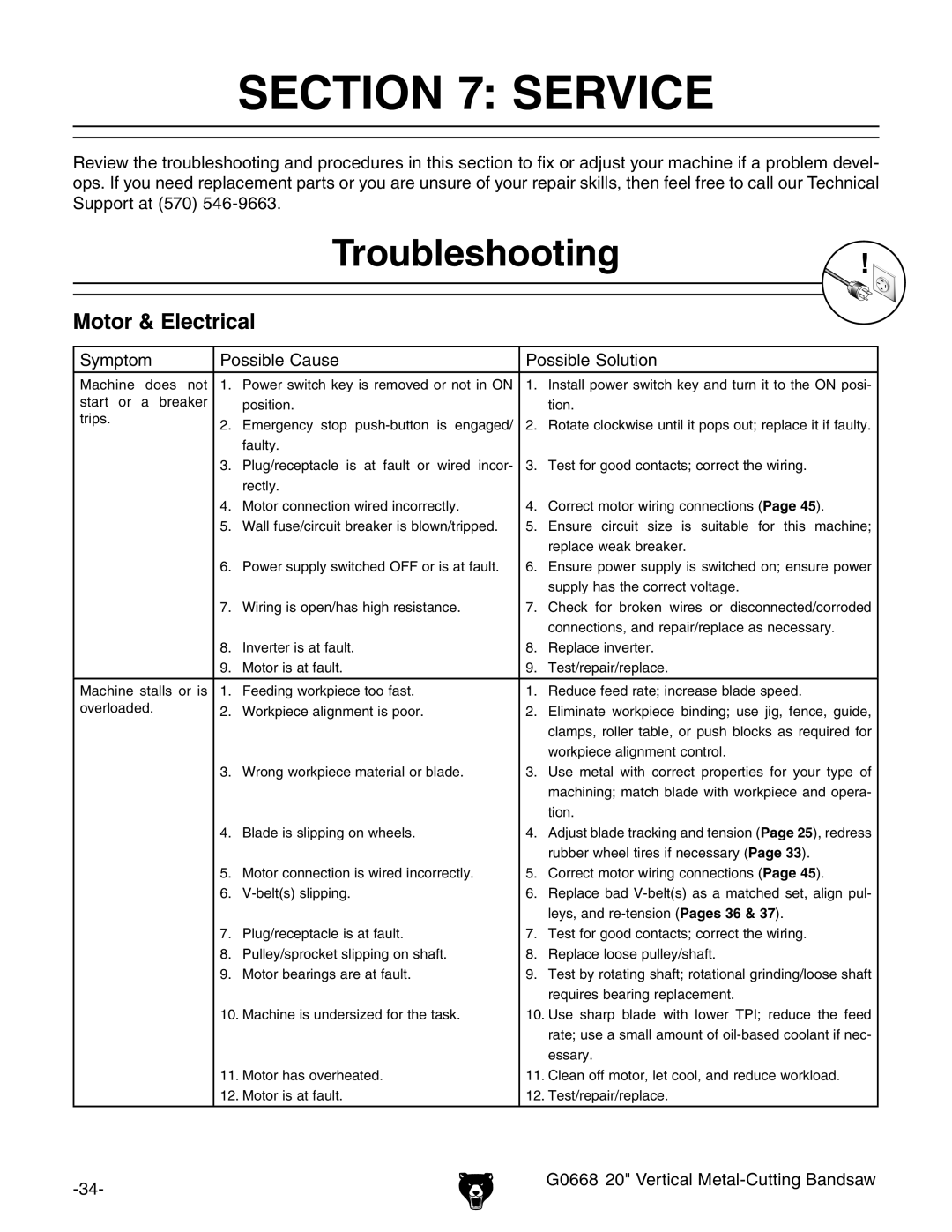
troubleshooting
SECTION 7: SERVICE
Review the troubleshooting and procedures in this section to fix or adjust your machine if a problem devel- ops. If you need replacement parts or you are unsure of your repair skills, then feel free to call our Technical Support at (570)
Troubleshooting
Motor & Electrical
Symptom | Possible Cause | Possible Solution | |||
Machine | does not | 1. | Power switch key is removed or not in ON | 1. | Install power switch key and turn it to the ON posi- |
start or | a breaker |
| position. |
| tion. |
trips. |
| 2. | Emergency stop | 2. | Rotate clockwise until it pops out; replace it if faulty. |
|
| ||||
|
|
| faulty. |
|
|
|
| 3. | Plug/receptacle is at fault or wired incor- | 3. | Test for good contacts; correct the wiring. |
|
|
| rectly. |
|
|
|
| 4. | Motor connection wired incorrectly. | 4. | Correct motor wiring connections (Page 45). |
|
| 5. | Wall fuse/circuit breaker is blown/tripped. | 5. | Ensure circuit size is suitable for this machine; |
|
|
|
|
| replace weak breaker. |
|
| 6. | Power supply switched OFF or is at fault. | 6. | Ensure power supply is switched on; ensure power |
|
|
|
|
| supply has the correct voltage. |
|
| 7. | Wiring is open/has high resistance. | 7. | Check for broken wires or disconnected/corroded |
|
|
|
|
| connections, and repair/replace as necessary. |
|
| 8. | Inverter is at fault. | 8. | Replace inverter. |
|
| 9. | Motor is at fault. | 9. | Test/repair/replace. |
|
|
|
|
| |
Machine stalls or is | 1. | Feeding workpiece too fast. | 1. | Reduce feed rate; increase blade speed. | |
overloaded. | 2. | Workpiece alignment is poor. | 2. | Eliminate workpiece binding; use jig, fence, guide, | |
|
|
|
|
| clamps, roller table, or push blocks as required for |
|
|
|
|
| workpiece alignment control. |
|
| 3. | Wrong workpiece material or blade. | 3. | Use metal with correct properties for your type of |
|
|
|
|
| machining; match blade with workpiece and opera- |
|
|
|
|
| tion. |
|
| 4. | Blade is slipping on wheels. | 4. | Adjust blade tracking and tension (Page 25), redress |
|
|
|
|
| rubber wheel tires if necessary (Page 33). |
|
| 5. | Motor connection is wired incorrectly. | 5. | Correct motor wiring connections (Page 45). |
|
| 6. | 6. | Replace bad | |
|
|
|
|
| leys, and |
|
| 7. | Plug/receptacle is at fault. | 7. | Test for good contacts; correct the wiring. |
|
| 8. | Pulley/sprocket slipping on shaft. | 8. | Replace loose pulley/shaft. |
|
| 9. | Motor bearings are at fault. | 9. | Test by rotating shaft; rotational grinding/loose shaft |
|
|
|
|
| requires bearing replacement. |
|
| 10. Machine is undersized for the task. | 10. Use sharp blade with lower TPI; reduce the feed | ||
|
|
|
|
| rate; use a small amount of |
|
|
|
|
| essary. |
|
| 11. Motor has overheated. | 11. Clean off motor, let cool, and reduce workload. | ||
|
| 12. Motor is at fault. | 12. Test/repair/replace. | ||
|
|
|
|
|
|
G0668 20" Vertical | |
|
